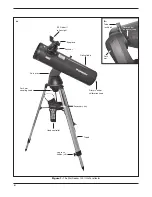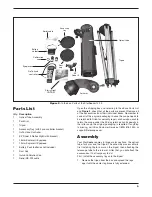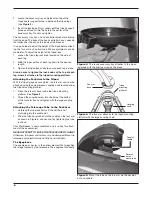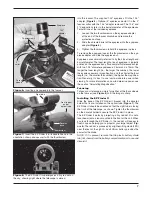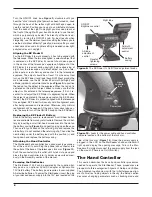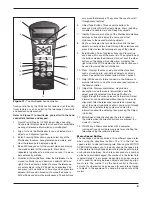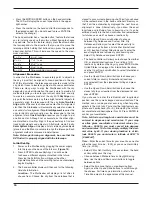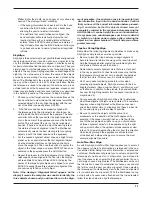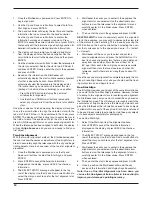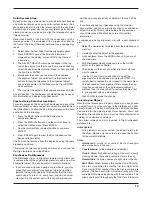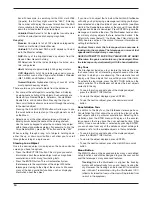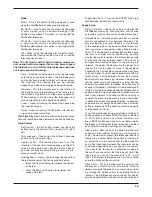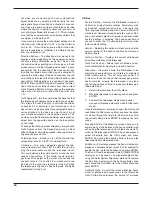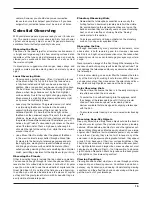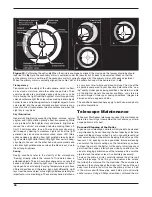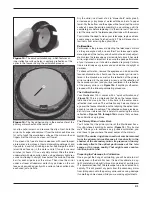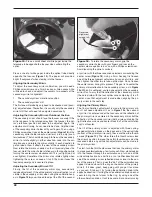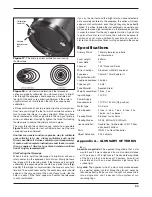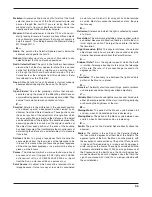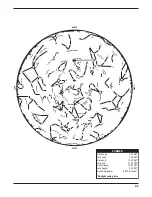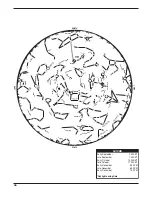
18
the telescope will then slew to the desired object with
enhanced accuracy. To use Precise GoTo:
1. Press the MENU button and use the UP/DOWN
keys to select Precise GoTo.
2. Choose Database to select the object that you want
to observe from any of the database catalogs listed
3. Choose RA/DEC to enter a set of celestial
coordinates that you wish to slew to.
4. Once the desired object is selected, the hand
controller will search out and display the closest
bright star to your desired object. Press ENTER to
slew to the bright alignment star.
5. Use the directional buttons to carefully center the
alignment star in the eyepiece. Press ENTER to slew
to the desired object.
Telescope Basics
A telescope is an instrument that collects and focuses light.
The nature of the optical design determines how the light is
focused. Some telescopes, known as refractors, use lenses.
Other telescopes, known as reflectors, use mirrors. The Star-
Seeker 130 II is a reflecting telescope with a primary and sec-
ondary mirror to gather and focus light.
Focusing
Once you have found an object in the telescope, turn the
focusing knob until the image is sharp. To achieve a truly sharp
focus, never look through glass windows or across objects that
produce heat waves, such as asphalt parking lots.
For astronomical viewing, out of focus star images are very
diffuse, making them difficult to see. If you turn the focus knob
too quickly, you can go right through focus without seeing the
image. To avoid this problem, your first astronomical target
should be a bright object (like the Moon or a planet) so that the
image is visible even when out of focus. It can even be helpful
to practice during the day on an object at least a mile away,
i.e., at “infinity.”
Image Orientation
The image orientation of any telescope changes depending
on its optical design and how the eyepiece is inserted into the
telescope. A refractor used with a star diagonal, for astronomi-
cal viewing, will show an image that is right side up, but left-
right reversed. When observing through a reflector such as
the StarSeeker 130 II, the image will appear upside down and
backwards. For this reason reflectors are not recommended
for daytime terrestrial observing. But since there is no “right
side up” in space, a reflector is fine for astronomical viewing.
Calculating Magnification
You can change the power of your telescope just by changing
the eyepiece (ocular). To determine the magnification of your
telescope, simply divide the focal length of the telescope by
the focal length of the eyepiece used. In equation format, the
formula looks like this:
Telescope Focal Length (mm)
= Magnification
Eyepiece Focal Length (mm)
Let’s say, for example, you are using the 25mm eyepiece. To
determine the magnification you simply divide the focal length
of the StarSeeker 130, which is 650mm, by the focal length of
the eyepiece, 25mm. Dividing 650 by 25 yields a magnification
of 26 power. For the included 10mm eyepiece, the magnifica-
tion is 650/10 = 65x.
Although the power is variable, each instrument under aver-
age skies has a limit to the highest useful magnification. The
general rule is 2x per millimeter of aperture. For example, the
StarSeeker 130 is so named for its primary mirror, which has
a diameter of 130mm. So 130mm x 2 = 260. Thus, 260x is the
highest magnification one can normally achieve under ideal
seeing conditions. Although this is the maximum useful magni-
fication, most observing will yield best results at lower powers.
Determining Field of View
Determining the field of view is important if you want to get
an idea of the angular size of the object you are observing. To
calculate the actual field of view, divide the apparent field of
the eyepiece (supplied by the eyepiece manufacturer) by the
magnification. In equation format, the formula looks like this:
Apparent Field of Eyepiece
= True Field
Magnification
As you can see, before determining the field of view, you must
calculate the magnification. Using the example in the previous
section, we can determine the field of view using the same
25mm eyepiece. The 25mm eyepiece has an apparent field of
view of 56°. Divide 56° by the magnification, which is 26 power.
This yields an actual field of view of 2.2°.
To convert degrees to feet at 1,000 yards, which is more use-
ful for terrestrial observing, simply multiply by 52.5. Continuing
with our example, multiply the angular field 2.2° by 52.5. This
produces a linear field width of 115.5 feet at a distance of one
thousand yards.
General Observing Hints
When working with any optical instrument, there are a few
things to remember to ensure you get the best possible image:
• Never look through window glass. Glass found in household
windows is optically imperfect, and as a result, may vary
in thickness from one part of a window to the next. This
inconsistency can and will affect the ability to focus your
telescope. In most cases you will not be able to achieve a
truly sharp image, while in some cases, you may actually
see a double image.
• Never look across or over objects that are radiating heat
waves. This includes asphalt parking lots on hot summer
days or building rooftops.
• Hazy skies, fog, and mist can also make it difficult to focus.
The amount of detail seen under these conditions is greatly
reduced.
• If you wear corrective lenses (specifically, glasses),
you may want to remove them when observing with
an eyepiece attached to the telescope. When using a
Summary of Contents for 8993
Page 27: ...27 Appendix C Time Zones ...

